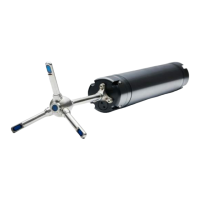Using a Velocimeter 27
© 2018 Nortek AS
capacity is crucial. We recommend starting new deployments with an empty memory.
9. For stand alone systems, it is vital to remember to connect the dummy plug to protect the
connectors.
2.1.4 Configuring a Vector
The Deployment Planning dialog contains all parameters required to specify the operation of the
instrument. The Deployment Planning frame on the right hand of the dialog displays performance
parameters that are automatically updated as you change the parameter settings.
The deployment Planning dialog allows you to specify the instrument operation at two levels. Use the
Standard tab to configure the system with default settings for various environments and mounting
arrangements. Use the Advanced tab to fine tune the operation parameters. It is recommended to
use the Help file that is available within the instrument software for a complete overview of each of the
setup parameters, what they mean and what effects tuning them has.
For general recommendations for sampling in specific environments, check out these sections:
Things to Consider, Applications and Common Configuration Scenarios.
Sampling Strategies
A general rule when selecting an appropriate sampling strategy is to consider how often you need
data and what type of variations you want to resolve.
Continuous sampling: the instrument is actively collecting data at all times until it is stopped.
Burst sampling: the instrument will sample rapidly for a set period of time. A general rule to figure
out the maximum sampling rate for a certain configuration is to consider what information you want
to resolve.
Figure: Sam pling sequence when an instrument is configured for Burst sampling, w ith 600 sec burst
interval, 300 samples at 1 Hz
Sampling Rate
When it comes to sampling rate, the general recommendation is that you will need to sample at
least twice as fast as the signal of interest in order to unambiguously resolve it (i.e. the Nyquist
sampling criteria). You will need to make a few estimates of what time scales and processes are of
interest and select a sample rate appropriate for those. For autonomous deployments: You need to
balance memory and power limitations also.
For example, when measuring waves, the sampling should be set up such that the wave record is
“well sampled.” This generally means the burst is greater than 15 minutes in duration. This can
easily be achieved if the instrument is set to 1 Hz and 1024 samples, or 2 Hz and 2048 samples.
This provides over 17 minutes of data and both examples are encouraged setups.
Internal Sampling Rate
The higher the velocity data output rate (for example by selecting 64 Hz in the configuration dialog)
the less internal averaging is occurring. This is related to the ping rate. Here are some relevant
terminology:
Ping rate: How often the instrument transmits pings.
Internal Sampling Rate: The internal sampling rate is fixed within each velocimeter according to its
acoustic frequency and velocity range. From a data quality perspective, the interesting parameter
is the internal sample rate
Sampling Rate: Parameter set in the software. It sets the output rate of the data. It also sets the
date at which data are recorded internally or to disk.

